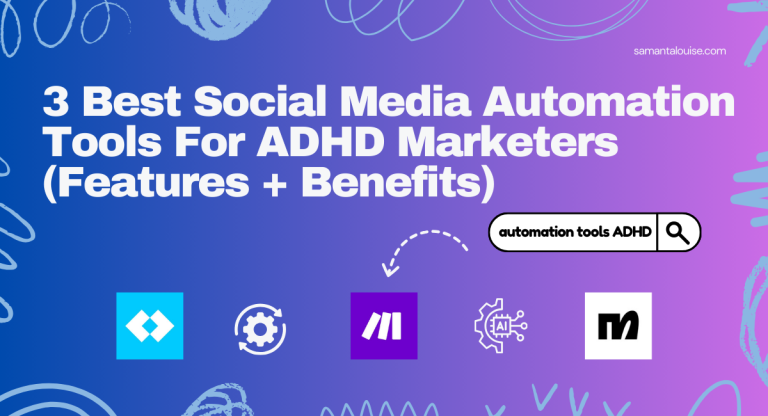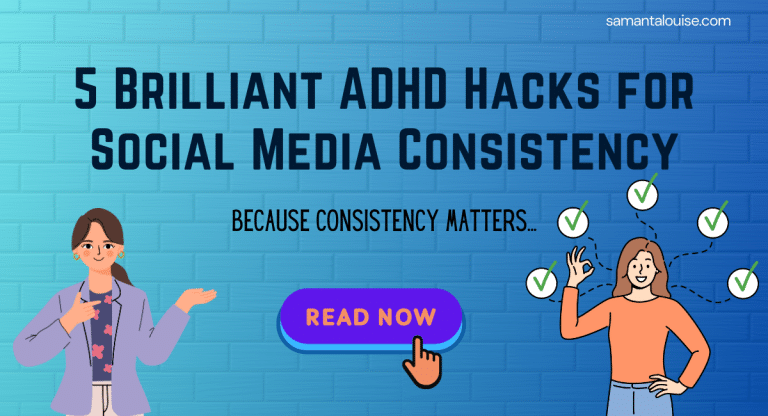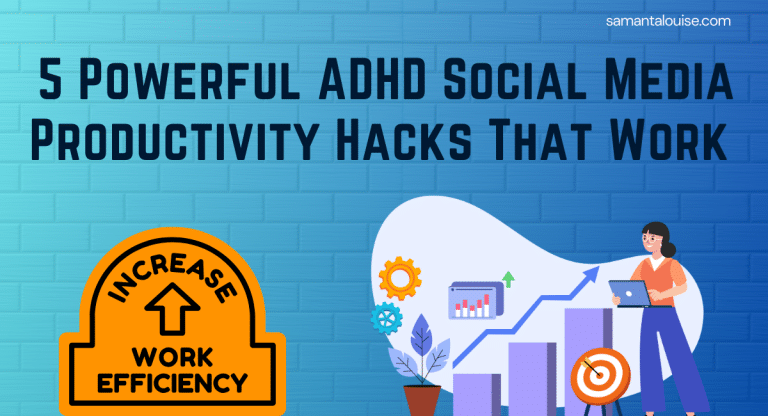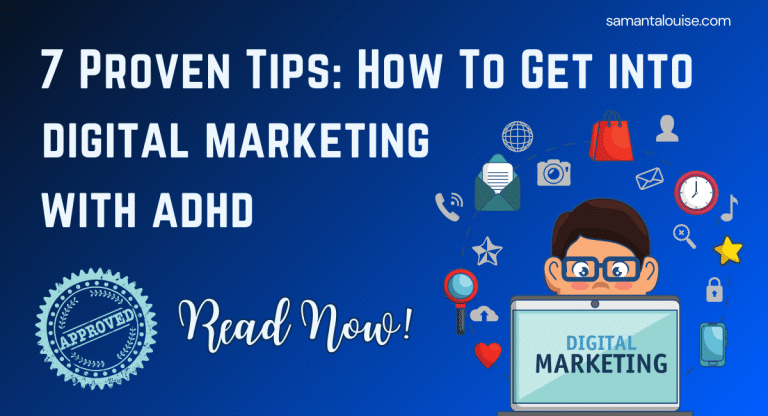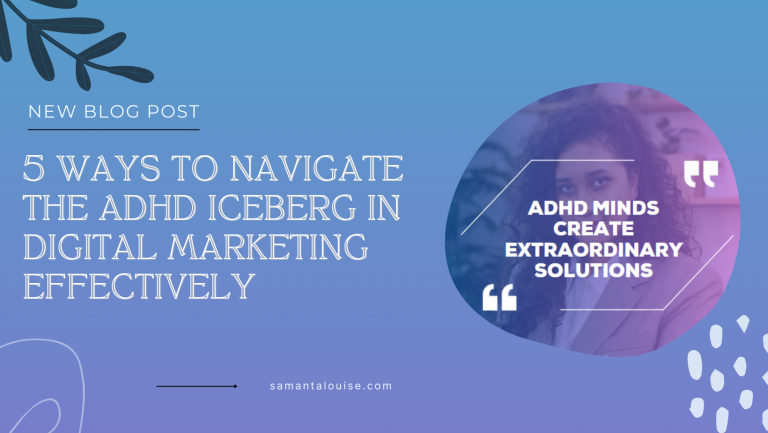Social Media Crisis Management For ADHD: 5 Key Steps to Take For Social Media Success In 2025
Did you know that 69% of brands have faced a social media crisis in the past year? Whether it is customers’ complaints gone viral, technical failures that hurt your products users or PR issues, these events have the power to tarnish your business reputation for good and force your business out of the market. These sudden stressful events can be overwhelming for ADHD marketers as they are unexpected and highly demanding. But here’s the good news – your ADHD traits like hyperfocus and creative problem-solving can actually become your superpower during a social media crisis management. Let’s turn what might seem like chaos into a structured, manageable process!
If you are an ADHD marketer, you might find this article on social media marketing for ADHD entrepreneurs helpful. It is a full-fledge article to help you navigate this world more easily.
In this article, I am going to talk about how to deal with a social media crisis from an ADHD marketer’s perspective. The aim is to cleverly utilize our unique ADHD advantages and protect our minds from stressful situations and be well prepared with an action plan when such a situation comes up. Use the table of content below to navigate the full article.
What Is Social Media Crisis Management?
Social media crisis management is your action plan for handling online reputation emergencies. Let’s say you have a steady social media presence and a brand name to go with it, and you wake up to vile comments, criticism, and posts from people online – well, that’s a social media crisis. What you decide to do next to calm people down and restore your reputation is social media crisis management. Think of it as your digital fire extinguisher – it’s what you use when something goes wrong on social media that could hurt your brand.
Types of Social Media Crises
To get a good picture of what a social media crisis, a few examples might help:
- Customer Complaints Gone Viral
- A negative review that spreads rapidly
- Multiple customers sharing bad experiences
- Screenshots of poor service going viral
- Technical Failures
- Website crashes during a launch
- Payment system issues
- Accidental posts or information leaks
- PR Issues
- Controversial statements
- Employee misconduct
- Misunderstood marketing campaigns
What Constitutes a Social Media Crisis?
In my experience as a digital marketer, I have experienced a few social media crisis and had to identify some when they happen. The hardest part about crisis is being able to take prompt action when they happen. You know that feeling when your stomach drops after seeing an unexpected notification? That’s often how a social media crisis begins.After helping many entrepreneurs navigate through digital storms, I’ve learned that what constitutes a crisis isn’t always what you’d expect. Social media is becoming more and important nowadays and a crisis can happen anytime.
To be totally honest, since I am not fully into social media marketing, I have not experienced more than a dozen social media crises, but I always like to follow profiles and brands who experience those and always set myself to learn about the best ways that these could have been managed. First, let’s break this down in a way that makes sense for everyone, especially my ADHD business owner friends. A social media crisis isn’t just any negative comment or bad review – those are regular business challenges. We’re talking about situations that require immediate digital crisis response and could significantly impact your brand’s reputation if left unchecked.
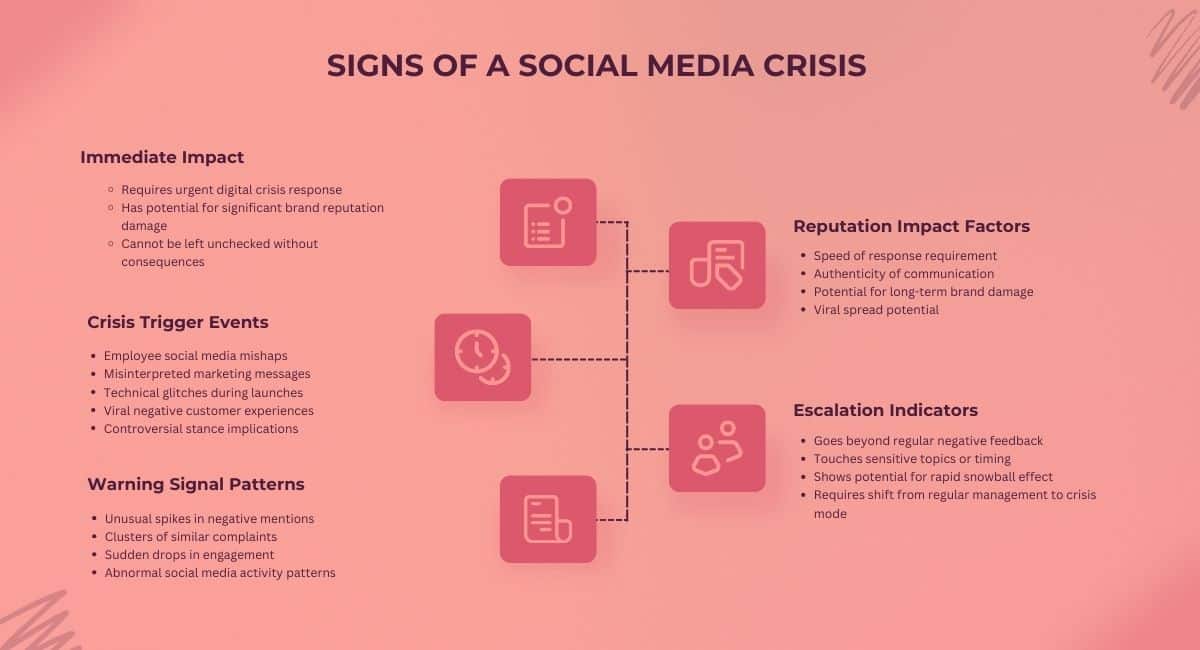
Through my few experiences with social media crisis planning, I’ve identified several common triggers that often spiral into full-blown crises:
- Employee mishaps (like accidentally posting personal content on the company account – yes, I’ve been there!)
- Misinterpreted marketing messages that blow up
- Technical glitches during important launches
- Viral negative customer experiences
- Controversial social or political stances (even unintentional ones)
Here’s something interesting I’ve noticed while developing crisis management frameworks – the warning signs often show up way before things get messy. You might see unusual spikes in negative mentions, clusters of similar complaints, or sudden drops in engagement. My social listening strategies have saved me more times than I can count!
As someone with ADHD, I have realised that social media crises can take a serious toll on our mental health and general performance. Traditional crisis management advice often falls short. Why? Because most crisis playbooks assume you can maintain perfect focus during high-stress situations. As someone who understands the ADHD brain, I know that’s not always realistic. You need systems that work with your brain, not against it.
The impact on brand reputation can be severe, but here’s what I’ve learned about brand sentiment analysis: it’s not just about the immediate reaction. It’s about how quickly and authentically you respond. I remember when one of my clients faced a crisis because their automated response system went haywire during a product launch. Their online reputation management recovery actually turned into a positive story because they handled it with transparency and humor.
The key to effective crisis prevention protocol is understanding that not every negative situation is a crisis, but every crisis starts as a negative situation. It’s about recognizing the difference and having the right real-time crisis monitoring tools in place to spot the transition. What constitutes a crisis for your brand might be different from others. I’ve seen small issues snowball into major problems because they hit at just the wrong time or touched on particularly sensitive topics. That’s why having a flexible crisis communication strategy is so crucial – it needs to adapt to different scenarios while remaining manageable for neurodivergent entrepreneurs.
How to Use ADHD Strengths in Crisis Management In Social Media?
If you are an ADHD digital marketer just like me having to navigate social media for crisis management, you might be interested in learning about how to use your ADHD strengths to overcome that nasty phase in the history of the brands you manage or represent. Instead of viewing my ADHD as a weakness, I had to change my perspective on crisis management, and this involves viewing my ADHD traits as strengths. I discovered this during a particularly intense digital crisis management situation that had me operating on all cylinders.
You know that legendary ADHD hyperfocus we sometimes get? Turns out, it’s an incredible asset for crisis management workflow. I remember when one of my client’s posts went viral for all the wrong reasons. Instead of fighting my tendency to hyperfocus, I channeled it into developing rapid crisis response templates. That intense concentration helped me spot patterns and connections that others might have missed during the chaos. So lets explore together which traits you can use to your advantage during a social media crisis.
1. Hyperfocus
You know that legendary ADHD hyperfocus we sometimes get? Turns out, it’s an incredible asset for crisis management workflow. I remember when one of my client’s posts went viral for all the wrong reasons. Instead of fighting my tendency to hyperfocus, I channeled it into developing rapid crisis response templates.
That intense concentration helped me spot patterns and connections that others might have missed during the chaos. Sometimes the pressure of having to do in a short span of time can trigger this hyperfocus mode and a social media crisis is indeed the type of situation that can glue you to your chair whilst biting your nails looking at your social media account but instead of just doing that, you might as well put that surge of energy to good use by taking action.
2. Problem-solving skills
Let’s talk about how our creative problem-solving abilities shine in social media crisis response. Where neurotypical folks might see a rigid path to resolution, our minds tend to bounce around different solutions and that’s actually perfect for crisis management! I’ve found that this natural tendency to think outside the box leads to more innovative reputation repair tactics. While others might get stuck in linear thinking, we can rapidly process multiple information streams. This makes us particularly good at social media monitoring and spotting potential issues before they explode. So maybe you should not curse yourself too much for some of your ADHD traits at times.
3. Pattern recognition
The pattern recognition abilities that come with ADHD? Pure gold for brand sentiment tracking. I’ve noticed that my brain naturally picks up on subtle shifts in social media engagement patterns. This has helped me develop more effective crisis prevention protocol strategies. It’s like having a sixth sense for when something’s about to go wrong – you just need to learn to trust it. I like to guess my way out of movie plots and many other things but being able to do the same thing in my job is a real advantage. In a way, you can use to fuel your social listening strategies.
Remember how people sometimes tell us we’re “too much”? Well, in social media crisis management, that intensity can be exactly what’s needed. Our natural ability to generate multiple solutions quickly can lead to more effective crisis recovery strategies. I’ve learned to embrace these traits rather than try to suppress them.
Through years of handling various digital reputation management situations, I’ve discovered that our ADHD minds are particularly well-suited for crisis response. We just need to create systems that harness our natural strengths instead of trying to force ourselves into neurotypical approaches to crisis management.
Building Your ADHD-Optimized Crisis Prevention System
At the end of the day, the aim is to ensure you do not get too overwhelmed to the point of burnout when experiencing a social media crisis. The key to effective social media crisis management for ADHD marketers is to maintain a system that prevent things from exploding right up in your face. And, if ever they do, you should have an ADHD-optimized strategy to manage the stress whilst dealing with the crisis.

A constant buzzing phone, endless texts from superiors and the team and dozens of spreadsheets are not the way to go. Since we are visual in many aspects, having a single visual command center is the right way forward. Here is what this approach looks like:
- Brand Monitoring Tools: A single-screen view showing key metrics
- Social Listening Zones: Different sections for different platforms
- Real-time Engagement Tracking: Moving elements that catch our attention naturally
- Crisis Alert Systems: Icons and symbols instead of text where possible
Let’s have a look at how to implement this in reality step by step in the next section.
Setting Up Your Monitoring Framework
The trick with automated monitoring systems is to make them impossible to ignore (but not so frequent that we tune them out). Here’s my crisis prevention framework:
- Alert Priority Levels:
- 🔴 Red: Immediate reputation management required
- 🟡 Yellow: Social Sentiment monitoring needed
- 🟢 Green: Routine engagement tracking check
- Crisis Notification System:
- Visual pop-ups for urgent brand protection issues
- Sound alerts for high-priority reputation threats
- Mobile notifications for critical social media crises
The key is to be notified at all costs of any irregularities and highlight the level of urgency for each situation so that it won’t go unnoticed.
Creating Your Crisis Response Toolkit
Let’s say you wake up to a social media crisis, what do you do first? What is the first step to social media crisis management? If you do not know, then you are in for a wild, unpleasant and bumpy ride and that’s what we exactly need to avoid as ADHD marketers. You need a crisis response toolkit that works specifically for the ADHD brain. It should be a dynamic, visual system that keeps you focused when everything feels chaotic. So what does this crisis response toolkit comprises of? It should not just a pretty or fancy name in your head even though we like to imagine things!
1. Emergency response templates
- Initial Response Framework:
- First 15-minute actions
- Key messaging points
- What NOT to say
- Platform-specific formats
- Social Media Templates:
- Twitter/X statement formats
- Instagram story sequences
- LinkedIn professional responses
- Facebook community updates
All of these things should already be available because if you wait till it happens to start drafting those, you are putting more pressure on yourself and we know the result of that – ADHD BURNOUT!
2. Visual Evaluation Checklist
If you know what the problem or situation is, you have already solved the problem halfway. Have a checklist in place to evaluate the situation! For example, questions you could ask yourself are:
- Is the crisis public?
- Is it viral yet?
- Is it growing on social media and expanding rapidly?
- Is it limited to a group?
Based on these answers, you can already know which course of action to take, for example, monitoring and responding if it is limited to a group or addressing that group specifically. If it is already viral, this calls for an immediate executive response. If it is only internal then take preventive action to restrain the crisis internally.
3. Emergency Contact System
You should organise your emergency contact system so that you can easily access them and by order of importance in each level of crisis. Here is how you could organise it:
- Tier 1 – Immediate Response Team:
- 🔴 Legal counsel
- 🔴 PR representative
- 🔴 Social media manager
- Tier 2 – Support Network:
- 🟡 Content creators
- 🟡 Community managers
- 🟡 Customer service leads
- Tier 3 – External Resources:
- 🟢 Industry experts
- 🟢 Media contacts
- 🟢 Platform representatives
4. Resource and Task Allocation Checklist
Finally, this is the most important piece of document to have when facing a crisis. You need to know what to do, who does it and when to do it. If you are having to figure out these things when everyone is under pressure, you will waste a lot of time in this stage. Indeed, there are some things that you will have to figure out on the spot but having at least 50% prepared will reduce your stress level by a ton. Here is what a crisis management checklist could look like:
Immediate Actions:
- Activate crisis monitoring dashboard
- Alert primary response team
- Access emergency templates
- Launch social listening tools
First Hour:
- Draft initial statements
- Set up reputation tracking
- Brief key stakeholders
- Establish monitoring schedule
What Are 5 Steps of Crisis Management + Action Plan For ADHD Marketers?
If you want to take a more systematic approach towards social media crisis management, the 5-step guideline is the right approach for you. Managing productivity in the workplace whilst having ADHD is not easy but with a standardized approach, digital marketers can do better at crisis management and in this section, I have adapted it to ADHD brains for you to be able to make the most out of it! So let’s get right into it.
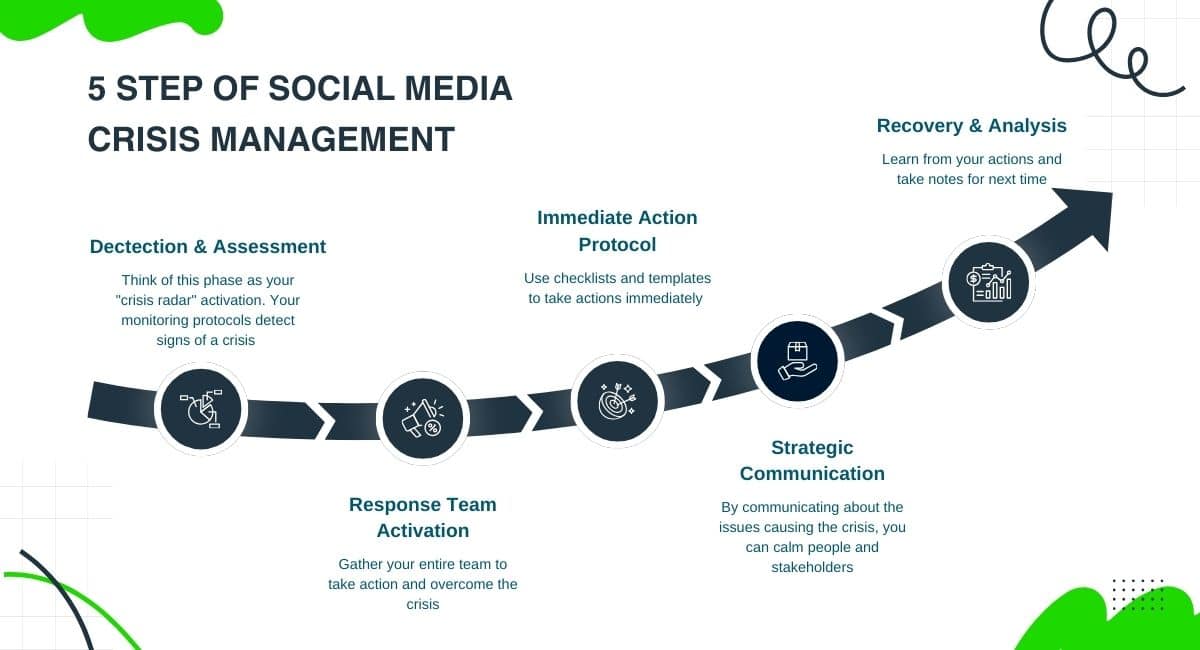
Step 1 – Detection & Assessment
Think of this phase as your “crisis radar” activation – it’s where your ADHD pattern recognition becomes your superpower.
Real-time Monitoring Protocols:
- Set up social listening alerts for:
- Brand name mentions
- Key product terms
- Executive team names
- Industry-specific keywords
Crisis Severity Scale
Use a crisis severity scale to assess the level of crisis on your social media accounts. This can help you prepare yourself and the team for future action. Here is an example of a scale I use:
Level 1: 🟢 Minor Issue
- Few negative mentions
- Limited reach
- Easy to address
Level 2: 🟡 Emerging Concern
- Growing negative sentiment
- Multiple platforms involved
- Potential for spread
Level 3: 🔴 Full Crisis
- Viral negative content
- Major stakeholder impact
- Media attention
Immediate Impact Assessment
You need to be able to assess the impact immediately even if it is not a detailed one. This assessment involve the following:
- Reach Analysis:
- Number of mentions
- Engagement rates
- Share velocity
- Sentiment Tracking:
- Positive vs. negative ratio
- Comment tone analysis
- Key criticism themes
In addition to this, you should be able to figure out which stakeholders are directly affected by this crisis, for example, direct customers, industry partners, industry partners, team members or even the media/public.
Step 2 – Response Team Activation
This is where your ADHD hyperfocus becomes your greatest asset – channel it into quick team assembly and coordination. You should have a proper hierarchy of who is responsible for which and who is accountable to whom. Things you should take into consideration are:
Communication Channels
- Internal Communications:
- 🚨 Emergency Slack channel
- 📱 WhatsApp group
- 📧 Email distribution list
- External Communications:
- 📢 Social media accounts
- 📝 Press release system
- 🌐 Website updates
Use the checklists and templates available to go through this stage fast. Your contingency action plan should be at the forefront of your strategy. Your resource mobilization checklist should be part of it to ensure that every resource is in the right place to deal with this new crisis. Here are some extra tips to remain calm during this phase.
- Use Your Hyperfocus:
- Set specific time blocks
- Use timer apps
- Take scheduled breaks
- Maintain Clarity:
- Keep checklists visible
- Use color coding
- Create visual reminders
- Stay Organized:
- Use digital tools
- Set up automated alerts
- Document everything
- Manage Energy:
- Rotate response teams
- Schedule breaks
- Keep snacks handy
Your ADHD traits like quick thinking, pattern recognition, and ability to hyperfocus are valuable assets in crisis management. This system is designed to channel these strengths while providing the structure needed to stay on track.
Step 3 – Immediate Action Protocol
This is where your ADHD quick-thinking shines – let’s channel that rapid response energy effectively. Even if you have templates and checklists in place, there are certain things you won’t be able to plan unless you know the context of the crisis. During that phase you will be required to take action based on the nature of the crisis. Here are things you will need to consider:
1. Communication Matrix
You should ensure you are communicating with the proper stakeholders and have all the information before taking actions. Sometimes a lack of information might lead to even bigger faux pas.
- Internal Teams:
- Brief format updates
- Action items clearly marked
- Visual status indicators
- External Partners:
- Situation summary
- Action points
- Support requests
2. Platform Specific Actions
You should have in mind already how to react on each platform. Here is how usually it is done for each social media platform:
- Twitter/X Response:
- Quick acknowledgment
- Thread format updates
- Direct engagement plan
- Instagram Strategy:
- Story updates
- Highlight collection
- DM management
- LinkedIn Approach:
- Professional statements
- Industry context
- Stakeholder engagement
Finally another important aspect of this step is to have a proper documentation system that helps you understand the evolution of the crisis and which steps to take at what stage. This involves taking relevant screenshots of comments and posts, timestampig key events, track engagement metrics and log all actions taken for future references.
Step 4 – Strategic Communication
Here’s where we leverage ADHD creativity for effective messaging while maintaining consistency. Communication is important in putting out fires and in crisis management on social media. By communicating about the issues causing the crisis, you can calm people and stakeholders and salvage the brand eventually, which is why it is important to have the following;
1. Channel Priority Matrix
It is important to note who to communicate first with and not lose time communicating with the wrong people. Time is of the essence in a social media crisis and wasting time will only worsen the situation. Here’s what a channel priority matrix would look like:
- High Priority:
- Primary social platforms
- Direct customer channels
- Media outlets
- Secondary Focus:
- Industry forums
- Partner networks
- Internal channels
2. Communication Timing:
Communicating is one thing and knowing when to communicate is another. The frequency is important as well. If it is a social media take down, then frequent responses might help put down fires or it could also wait a bit. It all depends on the context. Here is how you could deal with a typical social media crisis:
- Initial Phase (0-3 hours):
- Rapid responses
- High frequency
- Brief updates
- Management Phase (3-24 hours):
- Regular intervals
- Detailed updates
- Progress reports
3. Tone Guidelines:
The tone you use is important depending on the severity of the issue at hand. But here is the type of language you should use or not in general:
- Do Use:
- Clear language
- Empathetic tone
- Action-oriented statements
- Don’t Use:
- Technical jargon
- Defensive language
- Vague promises
Step 5 – Recovery & Analysis
Turn your ADHD pattern recognition skills into valuable insights for future crisis prevention. At the end of the day, you should be able to learn from your experience and plan for future crisis if ever there is one. With social media, you never know so better stay prepared.
1. Learning Documentation
After a social media crisis management phase, you should document as much as you can on what you did to make things work and the actions you took to manage this crisis at the best of your ability. This will save you work next time it happens if it is a recurring issue for your brand. Here are things you could document:
- Crisis Timeline:
- Trigger events
- Key decision points
- Resolution milestones
- Response Analysis:
- What worked
- What didn’t
- Team feedback
2. Strategy Adjustment Checklist:
You can use this experience to adjust your current templates and update them on what works best now.
- Update response templates
- Revise alert thresholds
- Modify team structure
- Enhance monitoring tools
Prevention Planning
You can use this opportunity to set up a preventive strategy and also get better at predicting crisis so that it won’t take you by surprise next time it happens.
- Risk Assessment:
- Identify potential triggers
- Map vulnerability points
- Create early warning systems
- Preparedness Updates:
- Refresh response kits
- Update contact lists
- Review automation tools
Your ADHD brain’s ability to process multiple streams of information and spot patterns quickly is invaluable in crisis management. This system helps channel those strengths while providing the structure needed for effective execution.
Social Media Crisis Management Best Practices and Tools
Social media crisis management is a serious and very important social media marketing duty as it can help a brand recover its reputation and put out fires. Therefore, it is equally essential to do it whilst following best practices that help you do this in a better way and be more efficient at it. In this section, I will go over the best practices and tools that you can use to ensure that you are doing this in the most effective and efficient way.
ADHD-Friendly Crisis Management Tools
1. Project Management Systems
Start with one main system like Trello or ClickUp. For ADHD brains, having everything in one place is crucial. Set up a crisis board with three simple columns: “Urgent Actions,” “In Progress,” and “Completed.” Add visual labels or stickers to mark priority levels. You can also keep your crisis toolkit in Notion with clear, short sections that you can access quickly. I keep all my templates and checklists in Notion. It is easy to share with the team.
2. Communication Platforms
Choose one main platform for your team – Slack works well for most businesses. Create a dedicated crisis channel called “crisis-alerts” where only important updates are shared. This helps avoid information overload. Set up a separate “crisis-discussion” channel for team conversations. For client or stakeholder communication, stick to email or Zoom calls to keep things professional.
3. Monitoring Software
Pick one social listening tool like Mention or Brand24 to track what people are saying about your brand. Don’t try to monitor everything – focus on your main social media platform and your brand name mentions. Set up simple email alerts for urgent mentions rather than trying to watch everything in real-time. You can also use Meta Business Suite to monitor comments on your Meta social media profiles.
Building Crisis-Resistant Social Media Presence
Preventive Measures
Write down 5-10 response templates for common issues. Keep them in a Google Doc or Notion template called “Quick Responses.” Save positive customer testimonials and screenshots in a folder called “Good Feedback” – these can be helpful during a reputation crisis.
Community Building
Post regularly on your main platform (pick one to focus on). Respond to comments within 24 hours – use social media automation tools. Share behind-the-scenes content once a week to build trust. Ask your community questions to keep them engaged. An engaged community will often defend your brand during crises.
Brand Voice Consistency
Create a simple one-page document with your brand voice guidelines. Include:
- How you say hello
- How you apologize
- How you thank people
- Words you never use
- Your typical emoji usage (if any)
Relationship Management
Keep a simple spreadsheet of key contacts:
- Important customers
- Industry partners
- Media contacts
- Brand advocates
Check in with these contacts monthly with a quick message or email. Strong relationships are your best defense during a crisis.
Next Steps
Now that you are equipped with a solid foundation for social media crisis management, and know exactly what a social media crisis is. Here are some extra tips to help you surmount this difficult phase as an ADHD marketer or social media marketer:
1. Morning Routine
- Check your monitoring tool first
- Scan important messages
- Update your crisis log if needed
2. Daily Management
- Set three specific times to check social media
- Use phone alarms as reminders
- Take breaks between monitoring sessions
3. Tool Rules
- Use only one tool for each purpose
- Turn off non-essential notifications
- Keep all passwords in one password manager
4. Energy Management
- Handle difficult tasks in your peak focus hours
- Save template creation for low-energy times
- Take regular breaks every 45 minutes
- Use productivity apps to keep you in check
If you liked my content, you will enjoy being part of my newsletter. I send FREE monthly resources for ADHD marketers. You can sign up by clicking HERE. In the meantime, you can explore my top article on time-blocking techniques for marketers with ADHD.

